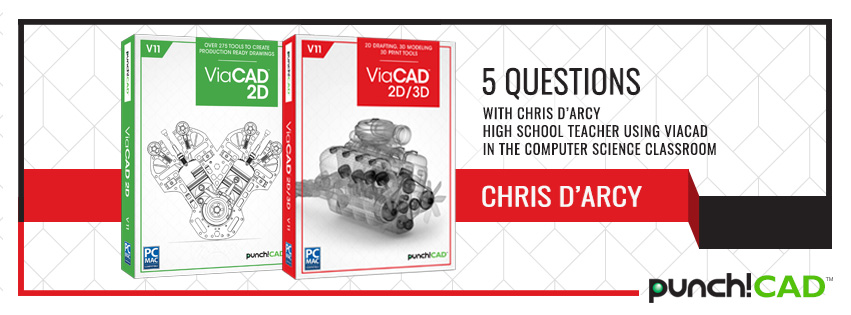Five Questions with Chris D’Arcy – High School Teacher using ViaCAD in the Computer Science Classroom

"Without question, the most contribution to the design process that CAD provides is the trigger and incentive to convert their imagination and creativity into reality. After that, the ease and speed with which CAD allows students to iterate between design and testing is perfectly suited for this generation's need to see results immediately."
How has CAD helped students in the design process?
All of us, at some point or another, have imagined a tool or device that could improve on the current standard. For most, this is where it ends as the path forward to realizing our creativity is unclear. Our Grade 10 students are introduced to the prototyping of electric circuits that they are expected to fit within a generic project box or repurpose an existing container they have lying around them. Within minutes of the start of their CAD introduction in Grade 11 they see the path forward to a custom, project specific housing or mount. So, without question, the most contribution to the design process that CAD provides is the trigger and incentive to convert their imagination and creativity into reality.
After that, the ease and speed with which CAD allows students to iterate between design and testing is perfectly suited for this generation's need to see results immediately.
How quickly did they pick up on the tools?
Four years ago when we introduced 2D ViaCAD concepts to Grade 11 students we budgeted for 6, 50-minute sessions. Now, we budget 2, 50-minutes sessions, and 2 more to introduce 3D concepts. This is not to say we go over each and every tool: we teach simply a few basics, then stand back, and turn them loose. They drive their pace of learning (again, as is the preference for this generation) and we sit back and wait for their questions to roll in.
We attribute the relative speed and ease with which students pick up the mechanics of ViaCAD's tool manipulations to both their intuitive software skills honed over the years of application exposure and their deep-seeted understanding that the quality of the educational experience depends, for the most part, on their own investment.
How has 3D Printing helped in the design process
To know that a design idea that pops in to their head in the morning can be turned into a physical reality and taken home later that afternoon is the catalyst for accelerated design thinking. As I said earlier, there are so many distractions for this generation of secondary school students that if you want them to remain focused, turnover has to be fast.Two years ago we outsourced our 3D printing. Last year we had two printers running the lab almost constantly. The plan is to add two more this fall. Four printers should be able to keep up with throughput demands. As well, knowing low resolution prints with quick turnaround confirm combinations of design changes and a powerful incentive to push their design development.
.
What kind of projects have the students taken on?
As mentioned earlier, our three-year pogram ACES (Advanced Computer Engineering School) program is aimed at giving students the ability to bring functional embedded devices of their own design to the working prototype stage. With CAD and 3D printing added to our curriculum in recent years, alumni that return from 4 years ago can hardly believe their eyes when they see how these tools have upped the ante. We have very small classes, typically 8 Grade 12 students so the sample size of projects is small.
Here is one from this past year:
The Robotic Hand by a Grade Eleven Student
What plans do you have for the future?
We currently have two 3D printers (a single-extruder workhorse and a higher-end dual-extruder). We intend to add two more printers (a second workhorse and a higher end printed capable of taller prints). This inventory of four 3D printers gives us the flexibility to meet anticipated demand from ever-increasing enrolment in our program.
Adding additional ViaCad licenses is also budgeted for. Finally, this year, we are going to take on the challenge of developing an autonomous vehicle from the ground up (chassis, body, drive train, sensors, and remote control, etc.) We think we're ready!
April 1, 2019
|
View: 4087





